Dual power in practice
Confederacies, local autonomy and neighborhood democracy: dual power practices have existed across North America from precolonial times to today.
Dual Power Then and Now: From the Iroquois to Cooperation Jackson
- Issue #9
- Author
The Cherán marching band is practicing for the Independence Day parade. Photo: Tim Mansel / Flickr
Long before the concept of dual power was used by Lenin to refer to the power of the workers’ councils vis-à-vis the state in the Russian revolution, and before Bookchin identified its potential as “as a blueprint for the revolutionary transformation of society,” practices that are now commonly associated with this revolutionary strategy were already widely practiced in North America, from the Haudenosaunee Confederacy to the New England Town Meetings. And the application of dual power strategies in local organizing and resistance — without necessarily identified as such — continues to this day, as witnessed in the autonomous community in Chéran, in the Mexican state of Michoacán and Cooperation Jackson, in Jackson, Mississippi.
There are numerous lessons to be drawn from the ideas and experiences of activists, Indigenous peoples and local organizers. The stories and histories presented below only make for a small selection of the many instances where groups and societies organized themselves to do away with centralized, top-down rule, and concentrated power in the hands of the community instead.
Throwing questions across the fire: Native American Confederacies
Cora Roelofs
To save our democracy, we need to return to our Indian democratic roots.
— Charles Riley Cloud
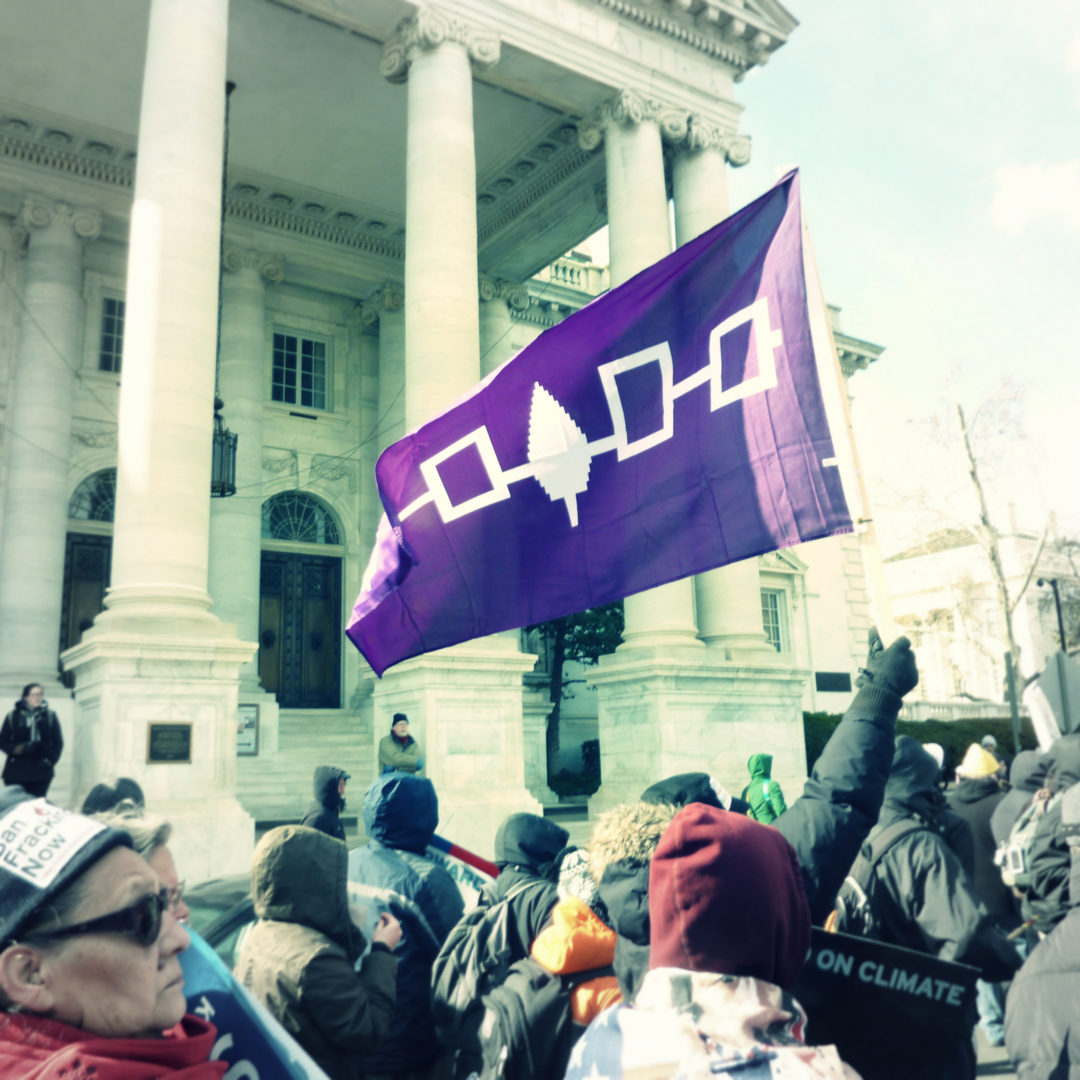
A contemporary Haudenosaunee flag at the Forward on Climate Rally in Washington, DC. February, 2013. Photo by Erica F / Flickr
At the time of European colonization of America, the continent was home to scores of Native confederacies. The purpose of confederation was to resolve disputes between different nations, to promote united diplomacy, and to assure united self-defense should diplomatic efforts fail.
The Haudenosaunee (Iroquois) Confederacy, which may be the best known, unites six nations of Turtle Islanders — Mohawk, Seneca, Onondaga, Oneida, Cayuga and Tuscarora — through a constitution called the Great Law of Peace, adopted around 1124, and persisting to this day in modified form.
The Great Law of Peace was built upon practices and values that had guided Native American peoples for centuries. These included reciprocity and equality between the sexes, checks and balances on power to prevent hierarchy, freedom from coercion, faith in deliberation and consensus-building processes, non-violent dispute resolution and restorative justice, adoption and kinship ties, the gift economy, respect and empowerment of gifted leaders, accountability and autonomy for clans to govern themselves.
Haudenosaunee Confederacy worked as follows: The Onondaga would kindle the fires to summon the council members, who had been selected by the clan mothers. Clan mothers also generally set the agenda for the meetings of the Grand Council. First, a topic would be discussed and debated between the Mohawks (“keepers of the Eastern door”) and the Senecas (“keepers of the Western door”).
Once these two nations found agreement, they would “throw the question across the fire” for the Oneida and Cayuga to discuss. When they too had reached consensus, the Onondagas decided the matter while assuring that the decision was consistent with the Great Law.
There are several checks and balances built into this system.
These council members — known as Sachem — were not kings or chiefs, or even elected representatives — in the sense of having authority to rule — but were accountable delegates from their autonomous nations. Poor performance in the role could result in the Sachem being removed from their duties by the clan mothers, who would give the title to someone else.
Clan mothers would warn these leaders that they needed to have “seven span skin” so their skin had to be “thicker than their erection was long” in order to withstand the critique they would be subject to by their people, including ridicule in public gatherings. The Great Law also provided for a sort of referendum process where people could propose their own laws for discussion.
Native peoples of North America worked for thousands of years to create resilient governance that balances the needs and rights of individuals and their communities, maintains and shares resources, prevents leaders from taking power from the people, and settles disputes peacefully.
While these systems have been deliberately undermined by genocide and colonization, including through replacement with Tribal Councils, the political traditions of Haudenosaunee Confederacy and other Native Americans survive, and are a rich bounty of guidance for those working to build equity and democracy today.
New England Town Meetings, an old tradition for modern times
Jay Moore
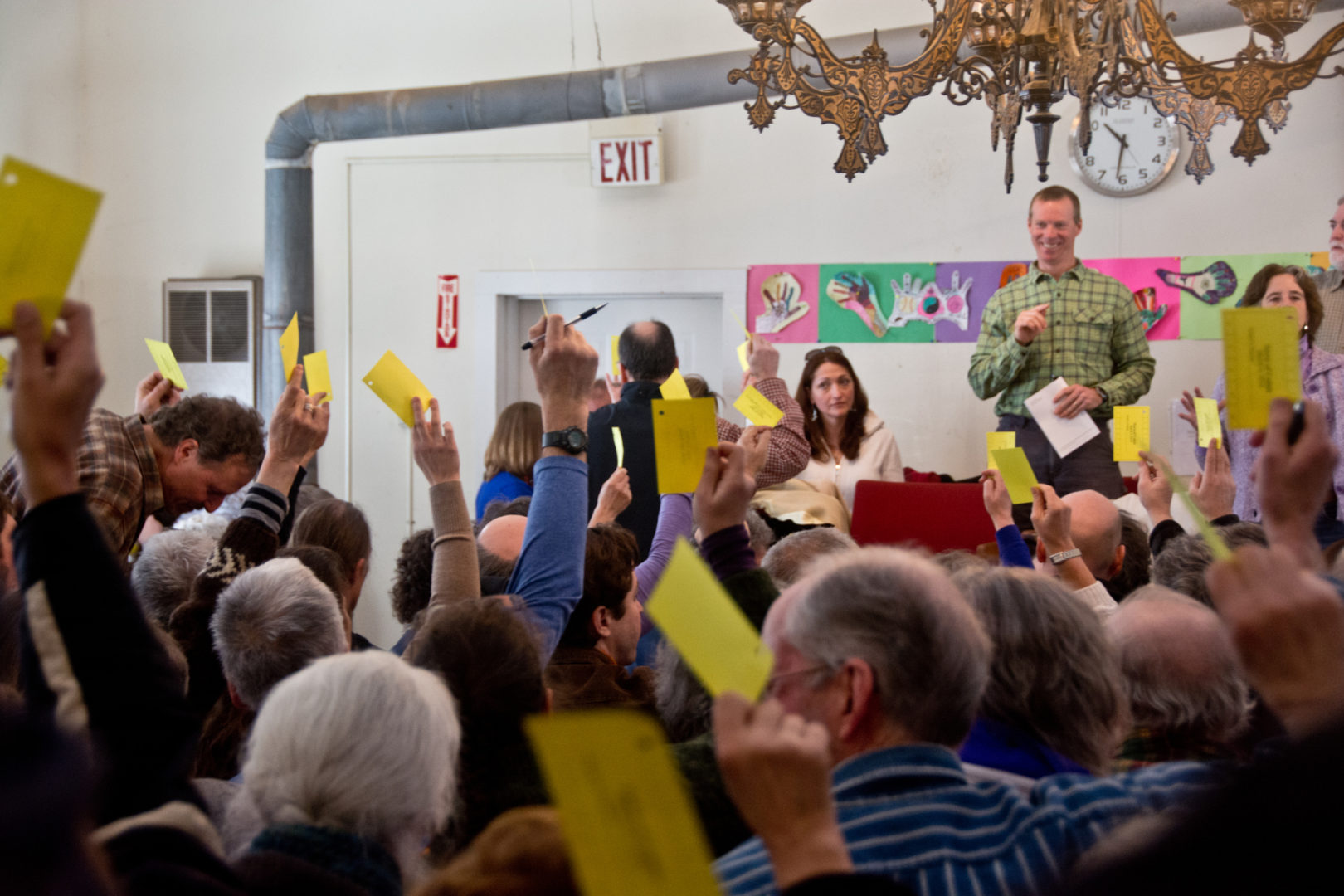
Voters raise yellow cards to register their vote at the Calais Town Hall during the school board meeting on Town Meeting Day. March, 2014. Photo by Erika J Mitchell / Shutterstock.com
As the years wore on and the populations of many New England towns grew, the Town Meetings fell out of mainstream popularity. But the tradition of Town Meetings persisted in rural and small towns, and in the latter half of the 20th century, they saw a powerful resurgence due to the work of local peace activists calling for a nuclear freeze. Today, regular Town Meetings take place in Connecticut, Maine, Massachusetts, New Hampshire and Vermont.
In most places, yearly meetings convene early in March when the community gathers to hear and discuss reports from the town officers and committees, to elect town officers for the following year, to debate and vote on the town’s budget — including appropriations for schools, fire protection and road maintenance — and to conduct other business.
The annual Town Meeting is also an important social occasion that allows townsfolk to reconnect with friends and neighbors at the tail end of the long New England winter.
If the need arises for more than the single annual congregation, the townspeople may petition to call a Special Town Meeting, or the Selectboard — the townspeople elected to run the town between the meetings and who are directly accountable to the community — may schedule a meeting in advance.
The original Town Meetings manifested out of necessity in a relatively isolated society without means of quick communication. But when adapted to today’s high velocity, information-dense culture, Town Meetings may have an even bigger impact than before. A robust system of local Town Meetings has potential as both a reliable tool for grassroots organizing and as a functional model of confederation.
Since 1982, successful multi-town campaigns have resulted in the towns of Vermont discussing and passing resolutions on US military aid to El Salvador (1983), marriage rights for the LGBTQ community (2000), the war in Iraq (2005) and the US Supreme Court’s Citizen United decision (2012).
In 2018, Vermont towns responded to Trump’s racist immigration policies by declaring themselves “sanctuary towns.” The same meetings have also seen towns passing resolutions calling for action on local, state and national levels to take firm and decisive steps to address global climate destabilization.
While these resolutions don’t happen spontaneously and don’t currently exert direct power over state or national politicians like they did in the past, they enable townspeople to take an active part in radical organizing and to spark wide discussion about crucial topics in the larger political landscape. They simultaneously function to build strong networks between townspeople, activists and the various modes of power accessible outside national political frameworks.
We would be wise to learn from and build upon the work being done in New England’s Town Meetings.
The radical history of neighborhood organizing in Montréal
Aaron Vansintjan and Donald Cuccioletta
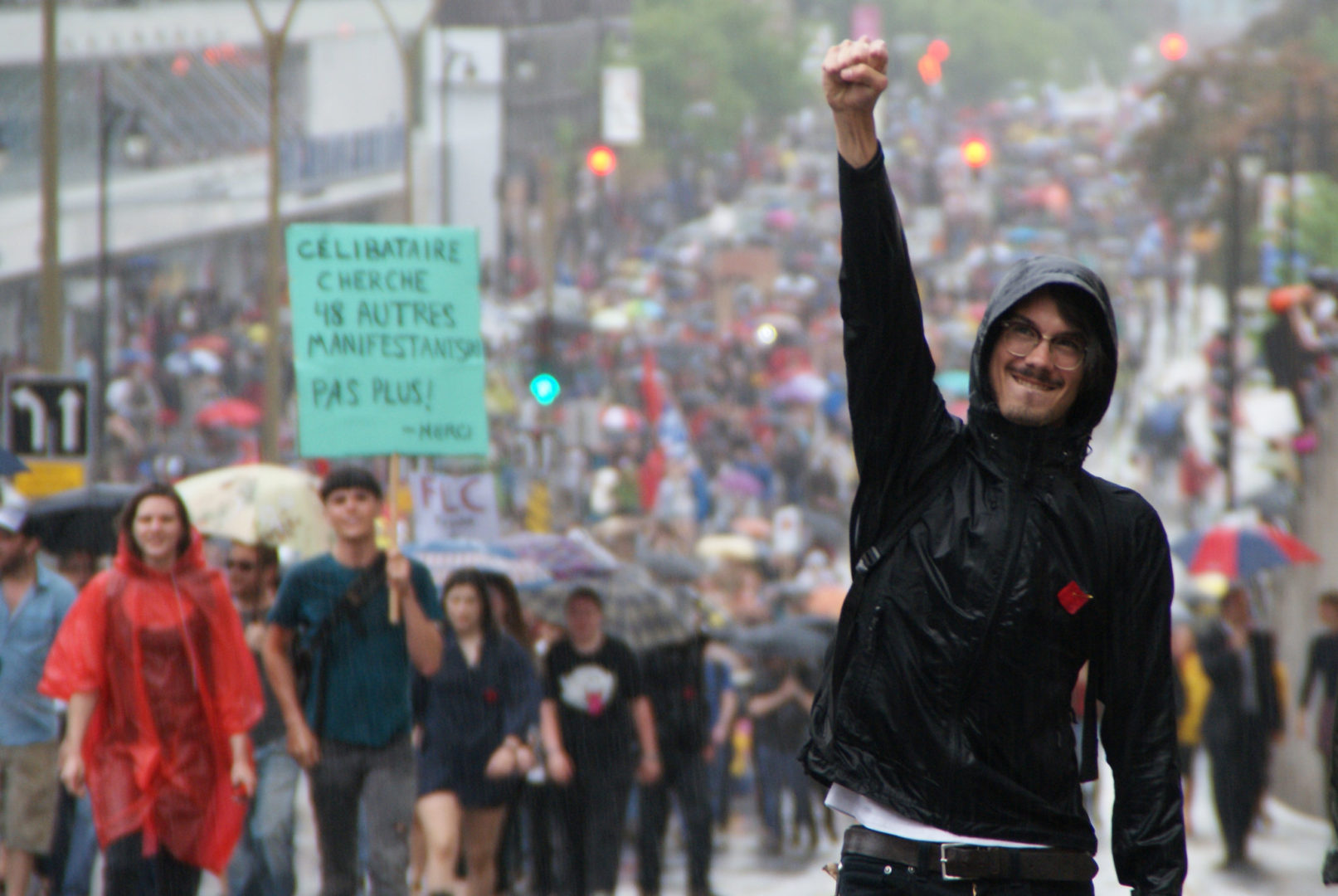
A protester raises his fist during the 2012 student protests in Montéal, Canada. Photo by G Morel / Flickr.
In the 1960s, Montréal’s citizens began organizing their own caring economy. They started up groupes populaires like citizens’ committees, collective childcare, cooperative housing and businesses, community-run clinics, neighborhood food cooperatives — the first of their kind in Quebec and Canada — and political action committees.
Residents of the Milton-Parc neighborhood organized what became the largest housing cooperative in North America. Citizens’ assemblies and tenant associations sprang up in different neighborhoods to coordinate these efforts. By the end of the 1960s, Montreal’s residents had built an ecosystem of mutual aid organizations by and for the working class.
At the same time, union leaders, recognizing the immense power coming from the quartiers populaires (people’s neighborhoods), began to see the need for a “second front” (deuxiéme front) beyond traditional labor organizing. In 1969, the FRAP (Political Action Front) — a coalition of grassroots municipal activists and autonomous political action committees based in the neighborhoods — formed a party and ran for city elections.
In the midst of the municipal campaign, growing political tension came to a head in the 1970 October crisis. Pro-Quebec independence radicals kidnapped a Quebec politician and a British diplomat. This resulted in a full-scale military occupation of the city by the Canadian Army made possible by the War Measures Act at the federal level, which suspended the Canadian constitution and habeas corpus. Many of the FRAP’s main leaders and candidates were arrested, and the party lost the election.
Shortly afterwards, Quebec unions called the largest general strike in North American history — with 300,000 workers joining the strike. This show of force led the government to take the threat of organized labor and neighborhoods seriously.
The 1970s and 1980s saw an expansion of the welfare state, involving slow integration of Montréal’s independent citizens’ initiatives. By the 1990s, the Quebec government had helped create a class of professional “community organizers” who spent much of their time competing for government funding, while having little incentive to help build up people-power.
In 2012, the massive student strike — the Maple Spring — sought to block tuition increases imposed by the Liberal government. An estimated 250,000 students from universities and community colleges went on strike across the province. Students were organized in a leaderless horizontal confederal model. Ordinary people joined the daily protest marches and began to self-organize neighborhood-based assemblies, which briefly confederated before withering away when the movement lost its momentum.
Today, Montréal’s social movements are once again turning toward radical municipalist action.
In 2018, activists opened Bâtiment 7, a huge self-run autonomous cooperative center in the working-class area of Pointe Saint-Charles, the same neighborhood where the first community health clinic was established in 1968.
Residents of Milton-Parc are organizing a series of conferences on municipalism and advancing a dual power framework. In response to the election victory of Projét Montréal, a “progressive” — but largely neoliberal — municipal party, radicals formed the Montreal Urban Left, an organization seeking to bring together radical municipal struggles around the city.
Throughout Montréal, there is a renewed interest in cooperative housing, and a growing movement for social housing and tenant rights, largely as a reaction to gentrification. Indeed, the housing movement is today emerging as the key struggle.
Montréal remains one of the most politicized cities in all of North America. This vibrancy is due, in large part, to past struggles — which shifted from traditional, top-down labor organizing by embedding the struggle in people’s daily life, building democracy at the level of the neighborhood.
Loisaida: local autonomy in the heart of New York City
Dan Chodorkoff
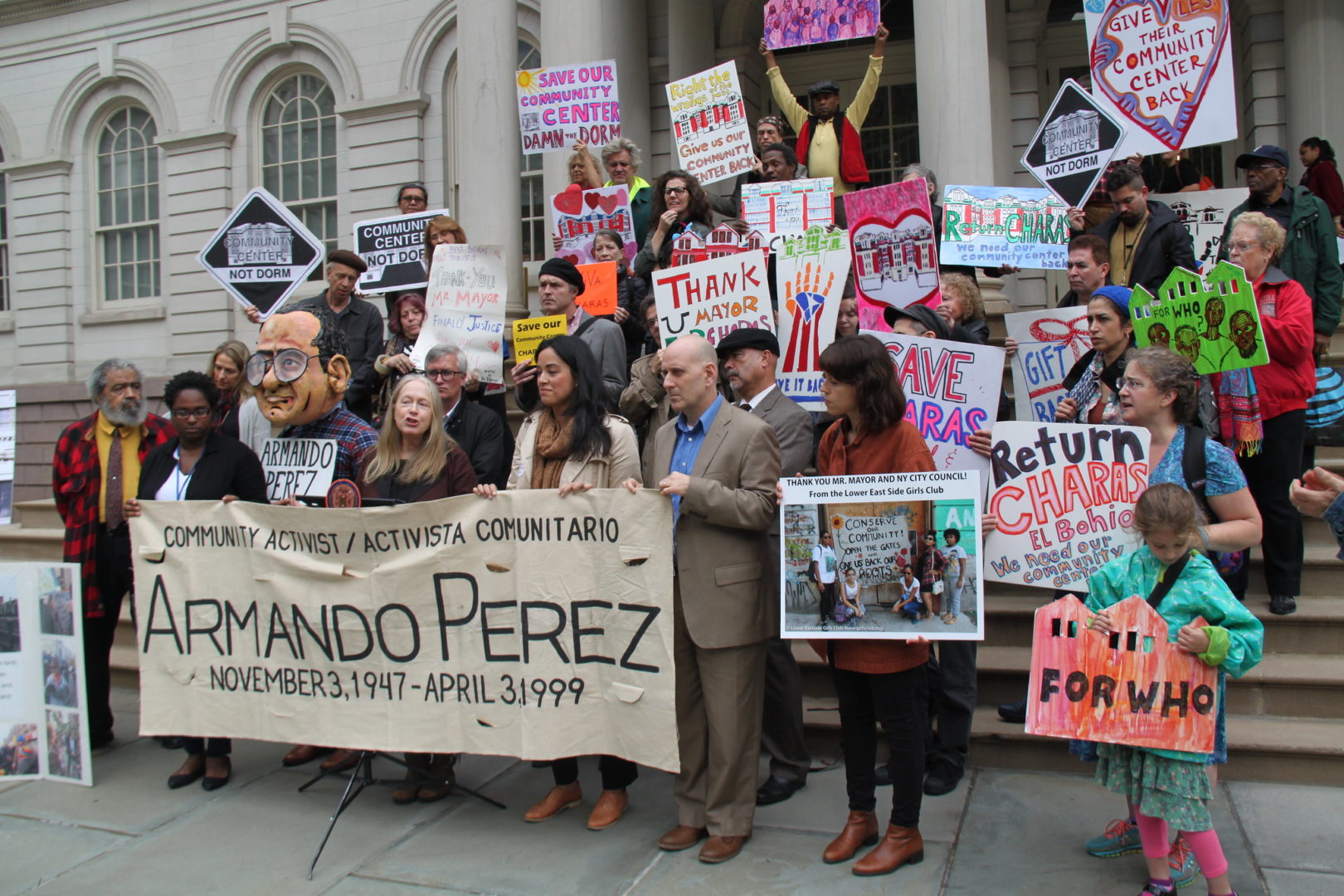
Memorial service for the Armando Perez, a community activist and co-founder of Lower East Side cultural center CHARAS. November 2017. Photo by Village Preservation / Flickr
At the time, Loisaida was the poorest neighborhood in Manhattan: the average income was $1,852 per year. Unemployment was estimated at 20 percent, with much of the remaining population working part-time or sporadically. Many buildings, including one third of housing options, were rapidly deteriorating or strewn with rubble and owned by the city. On some blocks, 60 percent of properties were abandoned.
Faced with this reality, the reaction of Loisaida’s residents was a radical, holistic restructuring of the neighborhood and a basic redefinition of urban life, based on a decentralist approach to town planning. The residents reintroduced food production to downtown NYC, using ecologically sound gardening and aquaculture techniques. They developed low-cost ways to use solar energy and even took over abandoned buildings and transformed them into tenant-owned cooperatives.
Guided by the principle of local self-reliance, Loisaida’s communities built their own systems of community-controlled schools, health care, law enforcement and governance; food production, housing, planning and land use; energy production and conservation, waste treatment and neighborhood economies. The members of the movement emphasized the interrelationship of their struggles and understood their communities as ecosystems, inherently non-hierarchical and mutualistic. They urged people to view their crises as symptoms of a deeper social and cultural malaise, stressing that natural systems find unity in diversity.
All this work was done bottom-up by grassroots organizations such as the 11th Street Movement, CHARAS and CUANDO, which advocated for cooperation and coordination through confederation. They envisioned “a world of neighborhoods” that maintained an accessible, human scale to ensure that the people controlled the decisions affecting their lives.
By 1978, the fruits of the communities’ labors ripened across the district. Vacant lots and rooftop gardens produced a bounty of fresh, organic vegetables; windmills and banks of solar collectors sprouted across rooftops, and a youth-run community center sported NYC’s first passive solar heating wall. Design work had begun on a permanent 2,400-gallon pond for raising fish in a closed-system aquaculture project.
But Loisaida’s years of neighborhood and community revitalization were just an important first step, and the larger economic and political forces of the city and nation-state eventually conspired to appropriate that work, catalyzing rapid gentrification. The neighborhood’s residents were forced to fight the forces of development intent on driving them from their homes.
Given the urgency of the crises we currently face — the Global North’s continued abuse of fossil fuels, the immediate threat of climate change, and the imperative to address all of these crises in a way that emphasizes freedom and equity — the lessons of Loisaida loom large, both as an inspiration and as a cautionary tale.
Efforts at radical sustainability, food sovereignty and decolonization are not only feasible: they are necessary.
Police-free Cherán, Mexico’s safest municipality
Addison Winslow
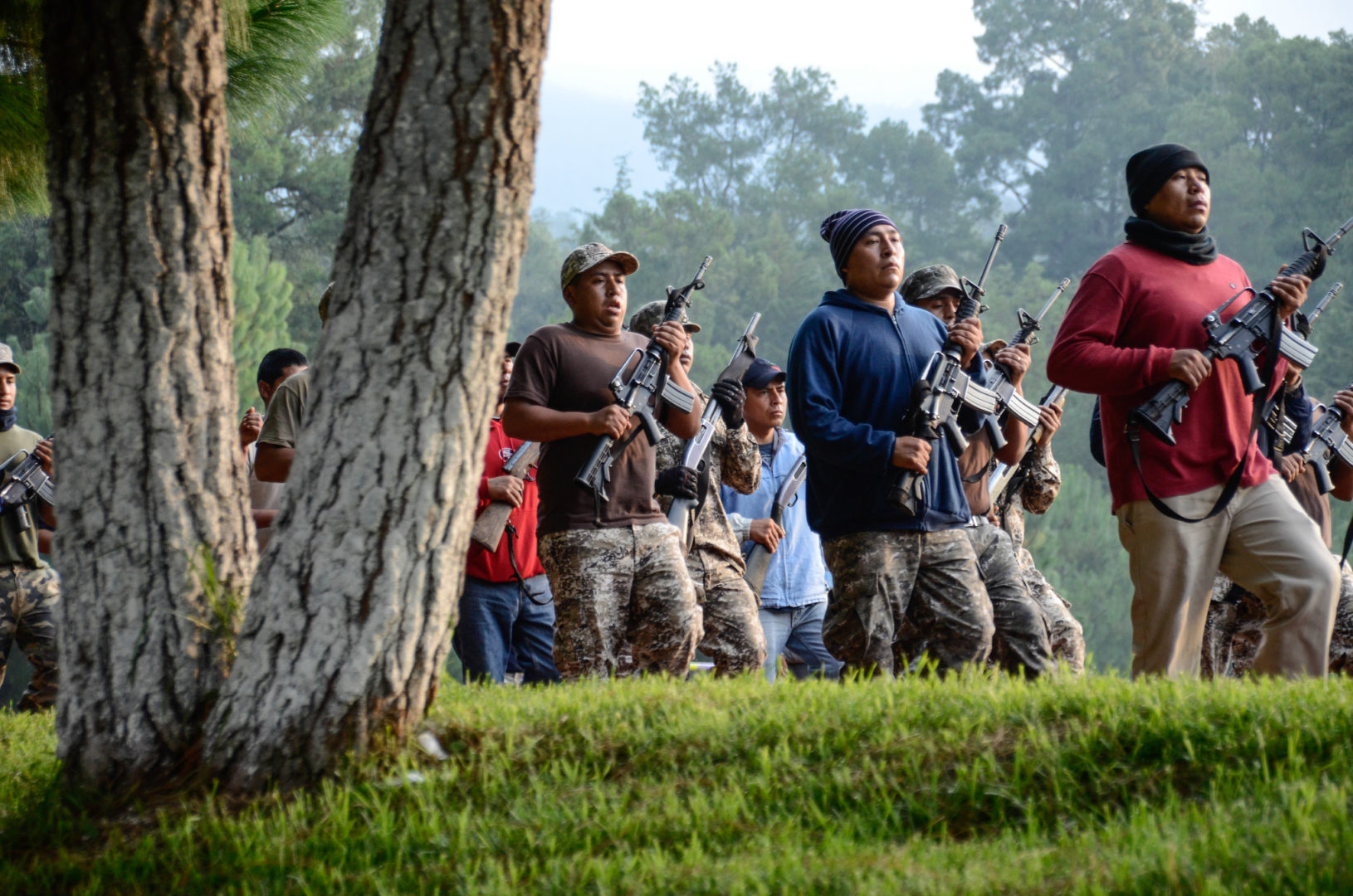
A community patrol in Cherán is practicing for the yearly Independence Day parade. November, 2016. Photo by Tim Mansel / Flickr
On the first day of the stand-off, the mayor and police were banished. Volunteers blocked the three roads entering the city, and people set up street fires on each block to serve as outposts. These fires, called fogatas, served to facilitate communication and diffusion of information as well as provide vigilance through the night. Fogatas are now the basic unit of Cherán’s system of government.
Cherán is a city of 20,000, the largest settlement of the Indigenous Purépecha people. They have longstanding traditions of communal governance, but before the uprising, Cherán was run like any typical Mexican city, with electoral contests between political parties.
During the uprising, Cherán resolved to ban political parties and replace them with communal government. About six months after the start of the uprising, the Supreme Court ruled in favor of Cherán’s right as Indigenous people to govern themselves according to their traditions. Since then, other municipalities have followed suit.
Cherán is now the safest municipality in Mexico, likely due to the rigorous accountability of their system of government. Community patrols organized during the crisis now receive modest salaries and patrol only their own neighborhoods. A rotating group guards the forests and maintains checkpoints on the entrances to the city.
Cherán’s political system, basically arranged by the time of the Court ruling, is an eminent example of neighborhood democracy. Anywhere from six to 60 people are grouped into a fogata, like a block club. They each have a regular meeting space and an elected coordinator. Issues are discussed at this level, and then are passed up via the coordinator to one of the four neighborhood assemblies. Information and news from the assemblies are likewise passed downward.
A 12-member council forms the highest administrative body of the city, but everything remains subject to the intense and often theatrical scrutiny by the neighborhood assembly. It is not uncommon for the inexperienced citizens chosen for the public councils and commissions to be scolded to tears before the dozens of gathered fogata coordinators, who might be live texting the events to people in other neighborhoods. It all makes for a robust and participatory public life, epitomizing the principle, “the people command; the government obeys.”
The Council of Common Goods administers Cherán’s numerous communal enterprises, but the assembly has every right to intervene and must be consulted on matters like production quotas, hiring and firing. Much to the vexation of the manager of the sawmill, the assembly refuses to permit the felling of healthy trees. Instead, Cherán pursues a massive reforestation project, including perhaps the largest tree nursery in Mexico. Meanwhile, the trees are used for resin, which is exported to Europe and the United States.
The city also owns and operates a quarry and block factory for construction, in addition to one of the largest rain catchment systems in Mexico. This was installed by the communal government in a crater on top of one of the surrounding hills, swiftly and utterly outcompeting the previous system of private water which relied heavily on imports.
Although Cherán planned early on to reduce economic dependence, state and federal government supports remain critical to the operation of the communal enterprises; and like much of Michoacán, remittances from workers in the United States are an important source of income, linking Cherán to external economic conditions.
If neighborhood democracy in Cherán is to withstand the unified hostility of Mexico’s political parties, and if the extraordinary model of democracy it represents is to be strengthened and expanded, they will need to develop economic independence to match the stability and self-determination they have achieved in their political system.
Cooperation Jackson: Building a Solidarity Economy in the Deep South
Sixtine van Outryve
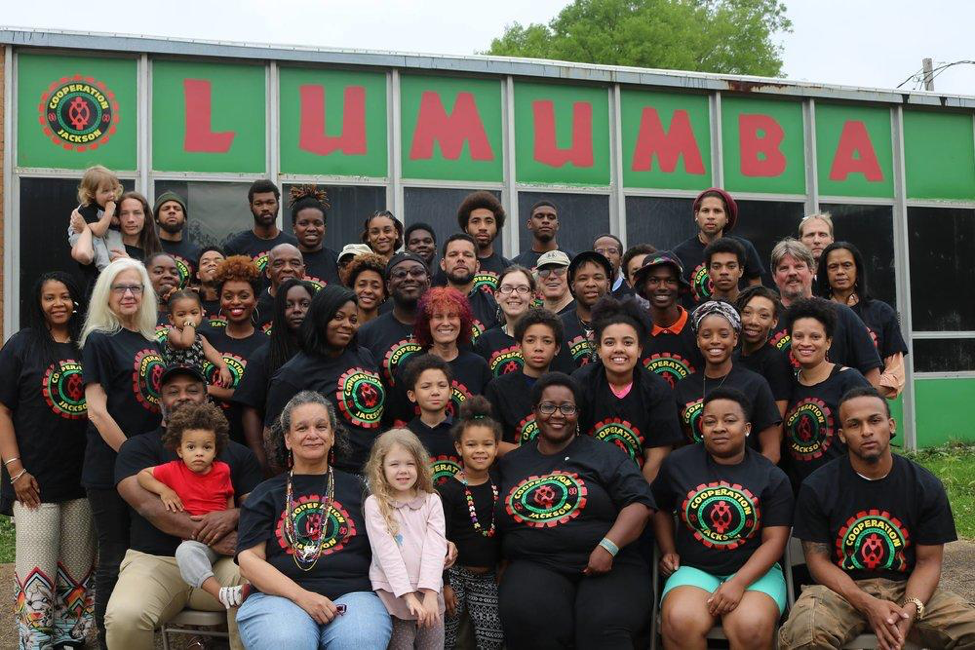
Members of Cooperation Jackson in front of Chokwe Lumumba Center for Economic Democracy and Development. Photo via cooperationjackson.org
Since the days of chattel slavery, the concurrent institutions of capitalism, racism and settler-colonialism have perpetuated the disposability of the black working class, first as enslaved and exploited labor, now as a marginalized population without access to secured jobs and decent living conditions.
As a hotbed of the civil rights movement in the sixties, Jackson has witnessed Black people rise through the echelons of predominantly white political institutions. However, access to economic power and the realization of economic democracy remains far from complete. To promote, warrant and ensure self-determination for the Black working class, the Malcolm X Grassroots Movement and the New Afrikan People’s Organization — both part of the tradition of the Black Liberation Movement — drafted the Jackson-Kush Plan.
This plan is an “initiative to build a base of autonomous power in Mississippi […] that can serve as a catalyst for the attainment of Black self-determination and the democratic transformation of the economy,” describes Kali Akuno, the author of the plan and co-founder of Cooperation Jackson.
Based on the principle that political self-determination is not possible without economic self-determination, the purpose of the Jackson-Kush Plan was to build autonomous power for achieving both. Three mutually reinforcing pillars constitute the heart of the plan:
- Building people’s assemblies as a vehicle of the autonomous political authority of the oppressed;
- Building a network of progressive political candidates to win municipal elections;
- Building social and solidarity economy as a transition step towards socialism.
The people’s assemblies were organized in Jackson to engage the public in autonomous projects to address the community’s issues, to wage strategic campaigns to put pressure on political and economic power and to create a culture of direct democracy. It was the people’s assembly that gave the mandate to, and organized the campaign for Chokwe Lumumba, a community lawyer and former vice-president of the provisional government of the Republic of New Afrika, to run for mayor.
Lumumba was elected in Ward 2 in 2009 and as Mayor of Jackson in 2013. The victories were part of the second pillar of the Jackson-Kush Plan. Unfortunately, on February 25, 2014, after only seven months in office, Lumumba died at the age of 66. His death was a major loss and setback for the movement and shut off access to the municipal legal, political and financial resources to realize the third part of the plan: to create the bases for social and solidarity economy. This project now animates Cooperation Jackson.
Born after the Jackson Rising Conference organized in May 2014, the purpose of Cooperation Jackson is to democratize the economy by granting Black communities the control over their own lives. It aims to provide the Black working class with access to the means of production and answers the community’s needs. Following the cooperative model of Mondragon in Spain, it intends to do so through the vehicle of a federation of workers’ cooperatives. Such a federation would operate at the same time as an incubator of workers’ cooperatives, a structure enabling their administrative, financial and material solidarity and a vehicle for political education.
The current active workers’ cooperatives within Cooperation Jackson are the Community Production Center, aiming to democratize the ownership, production and use of technology; Freedom Farms, aiming to realize food sovereignty in West Jackson; and a Green Team, a landscaping and composting co-op.
Cooperation Jackson is also working towards creating a community land trust as a way to secure affordable housing and to prevent gentrification in the neighborhood of West Jackson, one of the poorest areas in the city.
Despite a split between the movement and the current municipal administration, Cooperation Jackson continues to build towards self-determination, working through the difficulties of creating new forms of socialist relations under the constant pressures of capitalism and racism.
Source URL — https://roarmag.org/magazine/dual-power-then-and-now-from-the-iroquois-to-cooperation-jackson/
Next Magazine article
Social Ecology: Radicalizing the Climate Movement
- Katie Horvath
- December 22, 2019
Tenants’ Unions: Building Dual Power in the Neighborhood
- Jay Lucien, Varlam Akrat
- December 22, 2019

